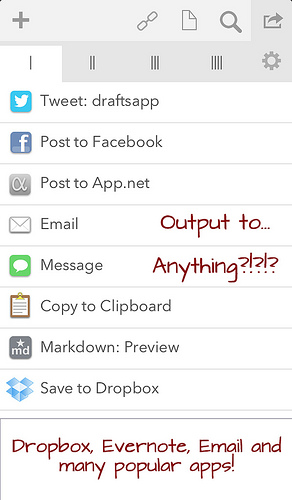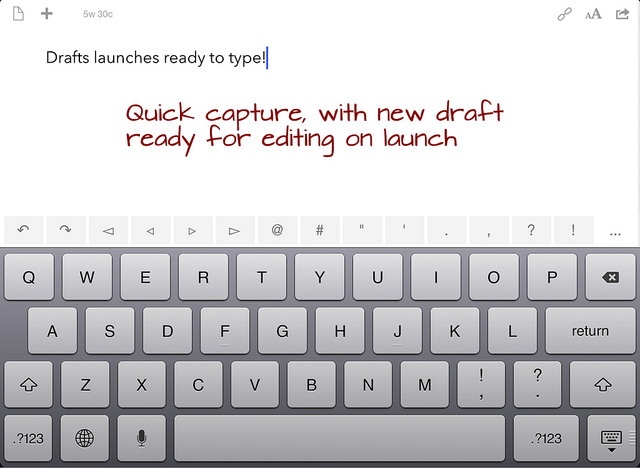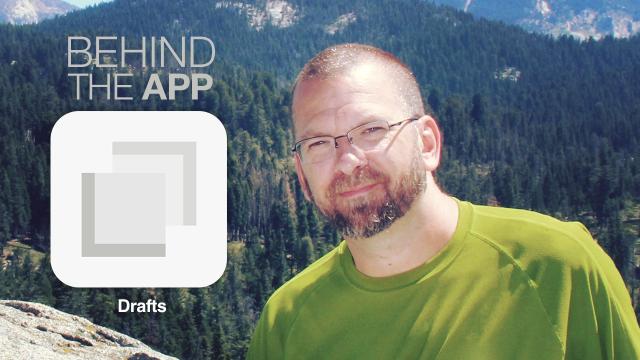After launching in 2012, Drafts quickly became one of our favourite note-taking apps. The brainchild of developer Greg Pierce, Drafts allows you to jot down ideas and either save them for later or export them. You can also use Drafts to search any website’s archive, and you can pair it with IFTTT to do all kinds of cool stuff. We caught up with Greg to find out how Drafts came to be, and to get his advice for aspiring developers.
Where did the idea for Drafts come from?

Drafts started out as something I wanted. It’s the only one of my apps that I can say started with a “eureka moment”. I was tapping away at a quick email to my wife one day, when I got half way through and realised I should be texting this message because she needed to see it right away. Sounds simple enough, but the mechanics of that context switch on the iPhone were clumsy. Tap and hold, select the text, copy to the clipboard, quit mail, launch the messages app, open a compose window, paste, address, send.
Pictured at right: Drafts on iPhone.
I thought about it and realised there were many times where I was trying to use my iPhone to capture some text before I really knew what I wanted to do with it. Whether that was for emails, texts or notes that would later go to a to-do list, calendar event or some other note store, like Evernote. I had the same problem with social networks, where I might start typing a tweet in a Twitter app and realised I want to put it on Facebook — or on both — and there was no easy way to do it.
What I wanted was something simple that launched quickly and let me start typing. Later, when I was ready to use that text, let me route it easily to any of the many other destinations that text might finally belong.
After you came up with the idea, what was the next step?
The next step for me was simply to start building the app. Drafts wasn’t my first app in the App Store. I had one small niche app that I had used to learn the ins and outs of the App Store process, and I had Terminology, a successful dictionary/thesaurus app for both iPad and iPhone.
As an independent developer, the only upfront investment for me was my time. I built the minimal version and started using it myself and showing it to friends. I was quickly convinced this was an app that would have a market — it was just too useful.
How did you choose which platforms to target and which to ignore or wait on?
iOS is what I know and what I use, so the question of what platform to target first was not difficult for me. The question of whether to target other platforms is still an open one. With an app like Drafts that deeply integrates with a number of different apps and services, it would be difficult to deliver a consistent experience across platforms — so for the time being I’m focused on delivering the best experience I can on iOS (both iPhone and iPad).
What was your biggest roadblock and how did you overcome it?
Drafts was not a big hit at it’s initial launch in April of 2012. Entering a crowded marketplace, the biggest roadblock was communicating what was unique about the app. Most iPhone owners already had something to take notes — either the built-in Notes app provided by Apple, or Evernote, or some other editor.
From simple screenshots, it’s not necessarily obvious what is different about Drafts and why it might make your life easier. It took time to communicate that message. I feel very lucky that sites like Lifehacker picked up on it’s uniqueness and helped get the word out.
What was launch like for you?
Launches are nerve wracking, but fun, too. The weeks leading up to a launch for a new app or a major update get hectic — the app is likely done, but the other “product” pieces need to fall into place. Website, screenshots, press releases, communication with the media outlets. It’s a lot of details and footwork to sort out. Once it’s finally out there, you take a deep breath and hope you’ve produced something people find useful.
I think it’s important not to put too much weight on “launch day” success, however. The App Store marketplace seems skewed to making a big splash on day one — and that’s great if you do. It’s also not the end of the world if you don’t. Drafts did OK on it’s initial release. It did better on version 2.0 and better still on version 3.0. It is possible to build a market over time in the App Store, even if it’s not the norm.

Pictured above: Drafts for iPad.
How do you handle user requests and criticisms effectively?
I’m Teflon-coated. When you’re an independent developer and put so much of yourself into your products, it’s easy to slip over the line and take criticisms personally. It’s important to maintain distance so you can be critical of your products, however. If you can’t do that, you are not likely to make good products — you have to know when you are wrong.
If you can maintain that distance, you create a lens through which you can evaluate your own ideas and criticisms of your products — and you can use that same lens to evaluate the requests and criticisms you channel from outside sources.
The important thing to remember is that if a person is taking time to send you a request, or a criticism, they are doing it because the care about your product. Even when I get those occassional criticisms that come off as rude or poorly thought out, I try to mentally rephrase them to fit the format, “Your app is useful to me, but would be that much more useful if it did or did not do X.” It almost always works.
Now, how do you split time between developing new features and managing existing ones?
Prioritising is tough. Bugs always come first. After that, honing existing features and improving overall quality. For new features, I’ve got quite a long list of requests. I listen to customer feedback and weigh it against what I think fits with the app and what the level of difficulty of integration would be. It’s always a balancing act.
What advice would you give others that want to take on a similar project?
Start small and have a plan to grow and sustain your business. It takes time to build good apps, it takes time to market them. Like any entrepeneurial activity, getting into the app marketplace requires a personality that is resilient, risk tolerant, and thrives on meeting new challenges every day.
Behind the App gives an inside look at how some of our favourite apps came to be — from idea to launch (and beyond).

Comments